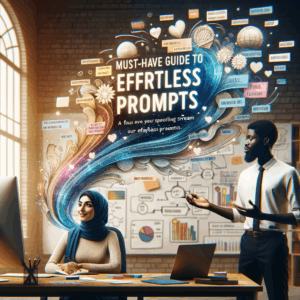
Ai Text Design: Stunning, Effortless Results
Introduction
You want text that looks great and reads naturally. You also want speed and consistency. ai text design answers both needs. It blends creative choices with machine power. As a result, you get stunning, effortless results fast.
This article explains how ai text design works. It also shares practical tips and tools. Finally, you’ll find examples, pitfalls, and future trends. Read on to design text that shines without extra friction.
What is ai text design?
ai text design refers to shaping written content with artificial intelligence. It covers tone, structure, formatting, and visual placement. In short, it merges writing craft with smart automation.
AI models analyze context and user intent. Then they suggest words, headings, and layouts. Consequently, you can refine messages faster and maintain a consistent voice.
Why ai text design matters
People skim more than they read. Therefore, clear and attractive text wins attention. ai text design helps you structure information for quick scanning. It also ensures tone matches your audience.
Moreover, teams need speed and scale. AI reduces repetitive editing. So teams can focus on strategy and creativity instead of tedious tasks. Ultimately, that improves quality and output.
Core components of ai text design
First, natural language generation creates the base copy. Next, style engines adjust voice and tone. Then, layout algorithms align headings and spacing. Finally, optimization tools handle SEO and readability.
These parts work together with user input. You give a brief or template. The AI then suggests drafts and refinements. This iterative loop produces refined content quickly.
How AI models shape tone and voice
AI analyzes large text sets to learn styles. It then mimics tone while following your rules. For example, it can write friendly product descriptions or formal policy pages.
To guide it, provide explicit examples. Phrase guidelines and word lists help too. As a result, the AI produces consistent copy for any channel.
Design principles for AI-generated text
Start with clarity. Use short sentences and simple words. AI favors clarity when generating readable text.
Next, use hierarchy. Headlines, subheadings, and bullets create structure. The AI can generate these elements automatically. So readers find key points at a glance.
Finally, add personality. Small stylistic choices make text feel human. You can instruct AI to include anecdotes, rhetorical questions, or light humor. These cues keep readers engaged.
Practical workflow for stunning results
Begin with a clear brief. Describe your audience, purpose, and tone. Then include examples of desired voice and structure.
Next, generate multiple drafts. Use AI to produce variations for comparison. Then edit selectively. Keep what works and revise what doesn’t.
Finally, run checks. Use grammar tools and SEO audits. Also test readability scores and mobile formatting. These steps ensure polished, effective copy.
Tools that make ai text design effortless
Several platforms specialize in AI-driven copy. Some focus on long-form content and storytelling. Others optimize headings and metadata for search engines. Choose tools that fit your goals and budget.
Here are categories and examples:
– Content generators: ChatGPT, Jasper, Writesonic
– SEO assistants: SurferSEO, Clearscope
– Editing tools: Grammarly, Hemingway Editor
– Layout and design: Canva Text Tools, Figma plugins
Each tool brings unique strengths. For example, SurferSEO helps with keyword intent. Meanwhile, Grammarly enforces tone and clarity.
Balancing automation with human creativity
AI speeds up the draft process. Yet humans still add nuance and judgment. Editors refine context and check facts. Designers ensure visuals match the text.
Use AI for iteration, not final authority. Combine AI suggestions with human edits. That approach yields the best results.
SEO and ai text design
SEO starts with intent. AI can identify search intent and suggest relevant topics. Then it crafts meta tags, headings, and internal links.
Use the keyword “ai text design” naturally across the copy. Place it in titles, subheads, and the first paragraph. Also optimize for related terms and questions.
Balanced optimization matters. Avoid stuffing keywords. Instead, focus on helpful content that matches user needs.
Readability and user experience
People prefer scannable content. So use short paragraphs and bullets. Add descriptive headings for easy navigation.
AI can produce readable sentences. Still, run a readability check. Simplify complex phrases and remove fluff. Good UX helps both readers and search engines.
Designing templates for consistent output
Create reusable templates to speed up workflows. Templates can include headings, call-to-actions, and tone notes. Then feed these to the AI when you generate content.
Templates save time and preserve brand voice. They also reduce back-and-forth editing. In teams, templates align all contributors with one style.
A table: Template elements for ai text design
| Element | Purpose | Example |
|—|—:|—|
| Title formula | Guide headline structure | “How to [Verb] [Audience] in [Time]” |
| Tone note | Define voice | “Conversational, helpful, concise” |
| CTA line | Encourage action | “Try the free demo” |
| Keyword placement | SEO guidance | Include primary keyword in H1 and first 100 words |
| Readability target | Scoring goal | Flesch-Kincaid Grade 7–9 |
Use such tables in your content brief. They help AI produce consistent drafts.
Visuals and typography for text-heavy pages
Typography affects legibility and tone. Choose fonts that fit your brand. Pair headings with readable body fonts. Keep line length between 50 and 75 characters.
Complement text with visuals. Images, icons, and pull quotes break up dense sections. AI tools can suggest image captions and alt text. That approach improves accessibility and SEO.
Tips for prompt engineering
Clear prompts lead to better outputs. Start with a concise brief. Then add examples and constraints. Specify length, tone, and format.
Use iterative prompts. First ask for an outline. Then request a full draft based on that outline. Finally, ask for revisions and shorter variants. This stepwise method reduces wasted generation and produces tighter results.
A sample prompt structure
– Purpose: What the content must accomplish.
– Audience: Who will read it.
– Tone: Voice and style specifics.
– Format: Headers, bullets, and length.
– Keywords: Primary and secondary terms.
– Examples: Two short samples of desired voice.
Follow this structure to maximize output quality.
Maintaining brand voice at scale
Brand consistency builds trust. AI can replicate voice across hundreds of assets. Provide a style guide and example copy. Then ask the AI to follow those rules.
Monitor output and provide feedback to the AI system. Many platforms learn from corrections. Continual training helps maintain consistent voice.
Ethics, transparency, and attribution
AI does not replace accountability. You must verify facts and cite sources. Also disclose when content relies heavily on AI, especially for opinion or medical topics.
Use AI responsibly. Avoid generating misleading, defamatory, or copyrighted text. Set internal policies for disclosure, review, and legal checks.
Common pitfalls and how to avoid them
Relying on AI without editing leads to errors. AI sometimes hallucinates facts or invents sources. So always fact-check critical claims.
Over-optimization can make text robotic. Avoid keyword stuffing and overly formal phrasing. Human revision restores warmth and clarity.
Finally, guard against bias. AI reflects the data it trains on. Use diverse examples and review outputs for fairness and accuracy.
Real-world examples and mini case studies
Example 1 — E-commerce product pages: A retailer used AI to generate 500 product descriptions. They set tone templates and quality checks. As a result, time-to-publish dropped by 70%. Conversion rates improved after A/B testing.
Example 2 — Content marketing agency: An agency used AI to create outlines and first drafts. Editors focused on storytelling and data verification. The team scaled output without losing quality. Client satisfaction rose while costs fell.
Example 3 — Internal knowledge base: A tech company used AI to standardize documentation. AI formatted sections and suggested FAQs. Engineers validated the content. New hires found answers faster and onboarding time shortened.
Measuring success and KPIs
Define metrics before you begin. Common KPIs include time-to-publish, engagement rate, conversion rate, and organic traffic. Use A/B testing to compare AI-assisted versus human-only content.
Also monitor qualitative metrics. Readability scores and user feedback matter. Track error rates and revision counts to evaluate efficiency.
Tips for effortless, stunning outcomes
1. Start small. Pilot AI on low-risk content.
2. Build templates. They increase consistency.
3. Combine AI with human editors.
4. Use analytics to iterate.
5. Keep a style guide and update it often.
These steps reduce friction and improve quality over time.
Collaboration between writers and AI
Treat AI as a writing partner. Writers can use it for ideation or first drafts. Then they apply craft, context, and checks.
Establish roles. For instance, AI drafts, junior writers edit, and senior editors finalize. This workflow balances speed and quality.
Future trends in ai text design
AI models will become more context-aware. They will better match user intent across channels. Also, multimodal models will combine text with images and audio smoothly.
Expect deeper personalization too. AI will generate content that adapts to individual reading habits. Meanwhile, regulations may require clearer disclosure about AI use.
Preparing your team for the future
Train staff on AI tools and ethics. Update workflows to include human review. Also create governance for content quality and compliance.
Finally, encourage experimentation. Teams that test new workflows gain a competitive edge.
Checklist: Launching an ai text design program
– Define goals and KPIs
– Select tools and platforms
– Create templates and style guides
– Run a pilot project
– Train the team and assign roles
– Monitor results and iterate
Use this checklist to implement ai text design responsibly and effectively.
Conclusion
ai text design gives you the power to produce beautiful, readable content at scale. It reduces repetitive work while preserving creativity. Still, you need human judgment and good governance.
Start with clear briefs, templates, and checks. Then combine AI speed with editorial craft. Over time, you’ll create text that looks stunning and requires less effort.
Frequently Asked Questions (FAQs)
1) Is ai text design replacing human writers?
No. AI boosts productivity but does not replace human judgement. Writers add creativity, context, and ethical oversight. Teams that blend AI and humans produce the best content.
2) How do I stop AI from making up facts?
Always fact-check critical claims. Use trusted databases and human editors to verify dates, statistics, and quotes. Require source citations when needed.
3) Will AI hurt my SEO by generating low-quality content?
Not if you guide it properly. Provide brief, templates, and SEO rules. Then edit for quality and relevance. Use SEO tools to ensure the content meets search intent.
4) How do I maintain a consistent brand voice?
Create a detailed style guide and example corpus. Feed those examples to the AI. Regularly review outputs and update the guide.
5) What legal or ethical issues should I consider?
Be transparent about AI use when required. Avoid generating harmful or misleading content. Check copyrights and respect privacy laws.
6) Can AI write for niche technical topics?
Yes, but you must verify accuracy. Use subject matter experts to review content. Provide the AI with technical glossaries or previous trusted documents.
7) How much time can AI save in content production?
Savings vary. Teams often report 30–70% faster drafting times for routine content. Actual gains depend on workflows and review processes.
8) How do I select the right AI tools?
Match tools to your needs. Choose generators for ideation, SEO tools for optimization, and editors for quality checks. Pilot multiple tools to compare results.
9) Is there a risk of biased content?
Yes. AI can reflect biases present in training data. Review outputs for fairness. Use diverse training examples and implement review processes.
10) How should I handle disclosure of AI usage?
Follow local regulations and platform policies. For high-stakes content, explicitly state that AI contributed. For marketing, clarify if AI wrote or assisted.
References
– OpenAI — ChatGPT: https://openai.com/chatgpt
– Jasper AI: https://www.jasper.ai
– SurferSEO: https://surferseo.com
– Grammarly: https://www.grammarly.com
– Hemingway Editor: https://hemingwayapp.com
– Canva Text Tools: https://www.canva.com
– Figma Plugins: https://www.figma.com/community/plugins
(End of article)

